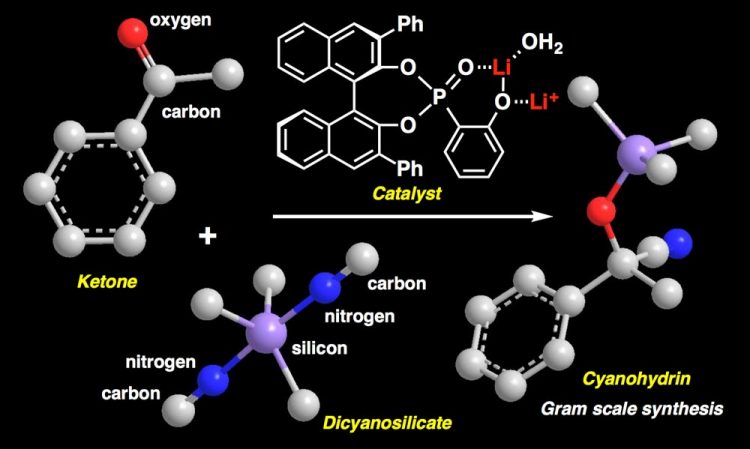Breakthrough Improves Method for Synthesizing Cyanohydrins as Pharmaceutical Precursors

A cyano group is added to a ketone using a chiral lithium(I) catalyst system to achieve control over the symmetry of the resulting pharmaceutical cyanohydrins. Copyright : Nagoya University
In the production of pharmaceuticals, it is extremely important to produce molecules that have the right kind of symmetry. Even products that have the same composition, but are mirror images of each other, can have different effects in the body.
Considerable interest has been generated by a recent advance made by scientists at Nagoya University, which was reported online in the journal Angewandte Chemie. Specifically, these researchers managed to modify molecules called ketones by adding new chemical groups in a way that produces more of a single mirror image of the same type of molecule.
This study extends previous work on modifying ketones to produce cyanohydrins, which are useful molecules because they are precursors of carboxylic acids and some amino acids, which are the building blocks of life. The similarity of cyanohydrins and their derivatives to amino acids means that they have important pharmaceutical properties.
However, in previous studies, the modification of ketones to produce cyanohydrins was inefficient, time-consuming, could only produce a small amount of desired product, and was only available for a narrow range of compounds.
These obstacles have now been overcome by an innovative new reaction. “Using a new catalyst, chiral lithium(I) phosphoryl phenoxide, we have been able to add a cyano group with excellent enantioselectivity on ketones using lithium dicyanotrimethylsilicate(IV),” says Dr. Manabu Hatano, an associate professor and the first author. “This reaction had a high yield despite only a weak Lewis acid catalyst being used.”
Previous studies in which efforts were made to produce optically active cyanohydrins encountered difficulties when using ketones rather than aldehydes as the molecules to be cyanosilylated because they are less reactive. This was overcome by the new approach, which was demonstrated by synthesizing a key intermediate for the production of (+)-13-hydroxyisocyclocelabenzine, a pharmaceutical that has antibacterial and antitumor effects.
“Another advantage of our new method is that the reaction time is much shorter, lasting only 2 to 9 hours rather than 1 to 2 days,” according to Katsuya Yamakawa, another member of the research team. “This would be helpful in the pharmaceutical industry when attempting to produce the desired products on a large scale for medical use.”
After the demonstration of this new catalytic system in a large-scale reaction, it is hoped that it can be applied widely for more effective cyanosilylation, enabling cheaper and more accurate production of pharmaceutical products.
The article “Enantioselective Cyanosilylation of Ketones with Lithium(I) Dicyanotrimethylsilicate(IV) Catalyzed by a Chiral Lithium(I) Phosphoryl Phenoxide” was published online in Angewandte Chemie, at doi: 10.1002/anie.201510682
Journal information
Angewandte Chemie, at doi: 10.1002/anie.201510682
Media Contact
All latest news from the category: Life Sciences and Chemistry
Articles and reports from the Life Sciences and chemistry area deal with applied and basic research into modern biology, chemistry and human medicine.
Valuable information can be found on a range of life sciences fields including bacteriology, biochemistry, bionics, bioinformatics, biophysics, biotechnology, genetics, geobotany, human biology, marine biology, microbiology, molecular biology, cellular biology, zoology, bioinorganic chemistry, microchemistry and environmental chemistry.
Newest articles

Trotting robots reveal emergence of animal gait transitions
A four-legged robot trained with machine learning by EPFL researchers has learned to avoid falls by spontaneously switching between walking, trotting, and pronking – a milestone for roboticists as well…

Innovation promises to prevent power pole-top fires
Engineers in Australia have found a new way to make power-pole insulators resistant to fire and electrical sparking, promising to prevent dangerous pole-top fires and reduce blackouts. Pole-top fires pose…

Possible alternative to antibiotics produced by bacteria
Antibacterial substance from staphylococci discovered with new mechanism of action against natural competitors. Many bacteria produce substances to gain an advantage over competitors in their highly competitive natural environment. Researchers…





















